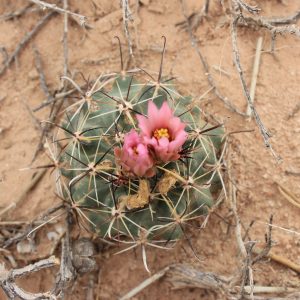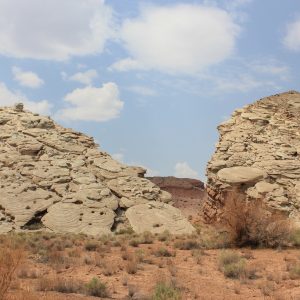The most recent month of my internship has been the quickest yet, which has made me realize how short five months really is…I don’t want it to end! I literally pinch myself every day because I feel so lucky to have a job I love so much.
Given that I live in the mountains, near a lake relatively close to the ocean, the surrounding landscapes of the San Bernardino National Forest are not as dry as some in the Great Basin where my CLM compadres are. We have been getting afternoon thundershowers nearly every day, making some plants that I have been surveying bloom for a second time when they normally just bloom in the late spring or early summer. It’s crazy!
The past month has been pretty mellow; I’ve been chipping away at cleaning up our geodatabase with field checks of rare plant occurrences. In other words, I’ve been going on daily treasure hunts in the mountains for beautiful, little-bitty plants, most of which are endangered. Much of our current geospatial information we have was created by my botanical predecessors (before my boss’s time) by judging from aerial photographs where certain plants were likely to occur. For the most part, the plant polygons are close to correct, but some are fixer-uppers. I haven’t had a field partner for two months due to a reorganization after budget cuts, so I’ve been going out in my green Chevy Tahoe all alone. Although it would be fun to have someone with me, I’ve been glad for the challenges that have come with flying solo and being completely unfamiliar with an area’s flora. I have become very self-sufficient and resourceful in my work ethic.
Other than looking for tiny plants that normal people wouldn’t notice or care about, I’ve been doing the GIS work that corresponds to my surveying project and working on my wildflower book of the San Bernardino National Forest.
A couple of weekends ago, I attended a lichen and air quality conference that was hosted by the Jepson Herbarium for Region-5 Forest Service botanists at the James Reserve in the San Jacinto Mountains. It was a wonderful opportunity to network with other FS botanists. A lichenologist, Linda Geiser from Oregon, came down and presented on the methodology that she has developed that uses lichens as air quality indicators. A local lichenologist, Kerry Knudsen, took us out in the field for a crash course in lichen genera field identification. The latter entailed many a minute with your nose pressed against the rock with one eye squinted and the other eye looking through your hand lens. Lichenology is a much understudied field, as I learned, so if you ever want to describe a species of something, you should probably become a lichenologist! The whole weekend was a fabulous experience and I felt very fortunate to be included in it.
That just about sums it up around here. I hope everyone else is having a great time with their internship! Here are a few photos:

Castilleja cinerea, my favorite paintbrush species and one of the threatened plants I survey/

A big Aspicilia lichen. It was huge!
Until next time!
Lizzy Eichorn, San Bernardino National Forest











